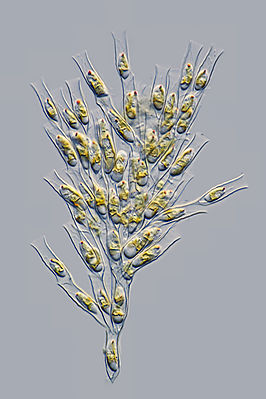Golden brown algae
| Golden brown algae | ||||||||||||
|---|---|---|---|---|---|---|---|---|---|---|---|---|

|
||||||||||||
| Systematics | ||||||||||||
|
||||||||||||
| Scientific name | ||||||||||||
| Chrysophyceae | ||||||||||||
| Pascher |
The golden brown algae (Chrysophyceae) form their own taxon within the stramenopile group . In addition, they are often referred to as golden algae (in the narrower sense), a term that was occasionally used for the no longer generally accepted, formerly superior taxon of the Chrysophyta .
description
The Chrysophyceae are microalgae, the organization of which can be unicellular flagellate , sometimes capsoid, coccoid, thread-like or with parenchyma. Macroscopic forms with thallus are the exception (e.g. hydrurus ). If there is a layer on the cell membrane, they have scales made of organic material or silicates, or cell walls made of cellulose . Other Chrysophyceae synthesize characteristically shaped Loricas , calyxes that completely or partially enclose the cells. In the species Poteriochromonas stipitata , the structure of the calyx consists of chitin , that of the species of the genus Dinobryon is formed by several cells together from silicate. Some species also have silicified, endogenously formed cysts . The reserve polysaccharide is chrysolaminarin .
The plastids are mostly golden brown to brown, which gives the group its name. The photosynthetic pigments are chlorophyll a and c 1,2 . Β- carotene as well as fucoxanthin , violaxanthin , anthaxanthin and neoxanthin ( xanthophylls ) are available as accessory pigments . The latter is the dominant dye. The chloroplast has a belt lamella. The outer membrane of the plastid is directly connected to the outer membrane of the cell nucleus via the endoplasmic reticulum. The plastid DNA is located in a circular genophore.
An eye spot may be present.
Floating forms have two flagella , one pointing forward and the other to the side. The mastigonema is in three parts and has short and long side hairs on the shaft. The kinetosome usually has four microtubular roots and one large striped root (rhizoplast).
Way of life
They mostly contain chloroplasts and are photoautotrophic . However, some species are dependent on vitamin intake , for example thiamine and biotin in the species Ochromonas danica or vitamin B12 in Poteriochromonas stipitata . In these species, heterotrophic nutrition predominates , but phagocytosis is also found in some species .
Almost all species reproduce asexually . Some species also reproduce sexually ( isogamy ), but in some species, for example in the genus Dinobryon , anisogamy has also been demonstrated.
ecology
Originally it was assumed that the golden brown algae were more common in fresh water than in sea water. This view was partially revised after it became known that they are a major part of what is known as nanoplankton . These are organisms in plankton with a cell diameter between 5 and 20 µm. The common plankton nets, however, have mesh sizes of 40 to 70 µm, so that nanoplankton were not included in many, especially older, plankton examinations.
Systematics
The golden algae contain around 1000 to 1200 species. They are closer to the synurid related (Synurophyceae). In the systematics of the eukaryotes by Adl u. a. In 2005 only three groups are given for the Chrysophyceae. Many of the subgroups previously placed here are no longer included in golden brown algae. What remains are:
-
Chromulinales , u. a. With
- Chromulina
- Uroglena : colony-forming
- Chrysomonas
- Gold Monads (Ochromonadales)
- Hibberdia
According to molecular biological findings by Klaveness et al. In 2011 the macroalga Hydrurus foetidus is definitely one of the Chrysophyceae. This species is found in cold, fast-flowing streams around the world.
literature
- Sina M. Adl, Alastair GB Simpson, Mark A. Farmer, Robert A. Andersen, O. Roger Anderson, John A. Barta, Samual S. Bowser, Guy Bragerolle, Robert A. Fensome, Suzanne Fredericq, Timothy Y. James, Sergei Karpov, Paul Kugrens, John Krug, Christopher E. Lane, Louise A. Lewis, Jean Lodge, Denis H. Lynn, David G. Mann, Richard M. McCourt, Leonel Mendoza, Øjvind Moestrup, Sharon E. Mozley-Standridge, Thomas A. Nerad, Carol A. Shearer, Alexey V. Smirnov, Frederick W. Spiegel, Max FJR Taylor: The New Higher Level Classification of Eukaryotes with Emphasis on the Taxonomy of Protists. The Journal of Eukaryotic Microbiology 52 (5), 2005; Pages 399–451 ( doi : 10.1111 / j.1550-7408.2005.00053.x )
- Dag Klaveness, Jon Bråte, Vishwanath Patil, Kamran Shalchian-Tabrizi, Ragnhild Kluge, Hans Ragnar Gislerød, Kjetill S. Jakobsen: The 18S and 28S rDNA identity and phylogeny of the common lotic chrysophyte Hydrurus foetidus . European Journal of Phycology 46 (3), 2011; Pages 282–291 ( doi : 10.1080 / 09670262.2011.598950 )
- Joachim W. Kadereit, Christian Körner, Benedikt Kost, Uwe Sonnewald: Strasburger - Textbook of Plant Sciences. Springer Spectrum, 37th completely revised & updated edition, Berlin & Heidelberg 2014. ISBN 978-3-642-54434-7 (print); ISBN 978-3-642-54435-4 (eBook)
Web links
- Entry in the Microbe Wiki (in English)
- Description on biologie.uni-hamburg.de (German)
